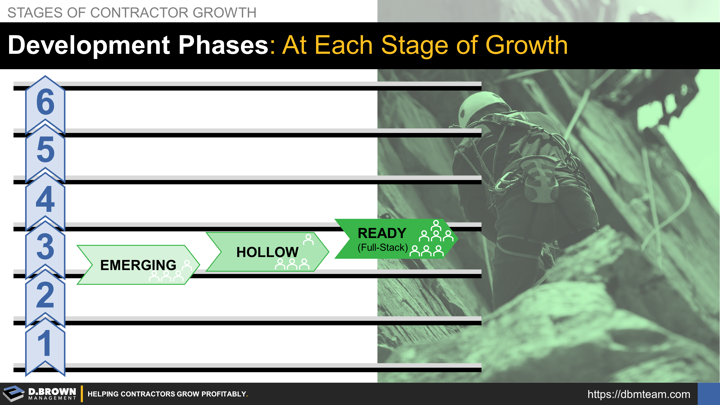Note that we are deliberate in the use of the term "Management" as compared to "Leadership" as we see more contractors struggle with growth due to gaps in their management systems than in their leadership. The ability to work with people and get things done through people is where management and leadership intersect. The key differences are:
- Leadership copes with change mostly in the external environment ensuring the business is positioned in the best place to win. These strategic choices are VERY important but in terms of total time make up a very small percentage of what the top 2-3 layers of management at any contractor spend their time on.
- Management copes with complexity in the environment both internal and external developing, managing, and refining systems, tools, and structures that create consistent outcomes given the inconsistency of inputs. Construction contracting is far more about scaling operational excellence than creative innovation. Most "creative innovation" in construction is truly only new to the person just now discovering it - 99.9% of it has been done before.
Basic Definitions of Each Phase
- Emerging: Top leader and management team all need to develop comfortable capabilities, capacity, and systems for their current stage of growth.
- Hollow: Top leader is comfortable in capabilities and capacity at the current stage of growth with strong desire and aptitude for the next stage of growth. There are gaps in desires, aptitudes, capabilities, or capacity in one or more roles below the leader including unfilled role. There are also likely gaps in the systems required for the next stage.
- Ready ("Full-Stack"): Top leader and management team are all comfortably executing at the current stage of growth with strong desire and aptitude for the next stage of growth. Systems are at least comfortable at current stage of growth with some being able to make it to the next stage of growth with only minor improvements.
Notes:
- We use the term "Full-Stack" as a reference to a Full-Stack Developer (computer programmer) who can work on both the front-end with the user understanding their needs, building the user interface or front-end, as well as develop the back-end including database, business logic, etc. From a construction contracting side thing of front-end like estimating, project management and field with back-end being accounting, HR, technology, equipment, etc.
- If a team is evaluated as "Emerging" or "Hollow" - at what stage of growth were there comfortably capable?
- Note that a team can move from "Ready" to scale to the next stage of growth back to "Hollow" very quickly with a single key person either retiring or being recruited away. The dichotomy of growth is that to grow you need people and people are hard to attract but without growth, there is no opportunity and people will be even harder to attract or will leave. Talent at the leadership levels for contractors will only continue to worsen through 2030.
Leadership Focus and Stage of Growth
A good rule of thumb is that the top leader (Owner/CEO/President) must be:
- Comfortably capable or moving in that direction for the current stage of growth.
- Actively developing others on the management team toward their appropriate level of leadership focus and specialization for the current stage of growth.
- Allocating 10% or so of development time for themselves and others on the management team to build deeper understanding of what is required for the next stage of growth including deliberate practice to get there.
- Objectively evaluating the growth trajectory, aptitude, desires, and behaviors of themselves and others on the team to ensure that the business planning is in alignment with the talent pipeline starting at the top.
Two great quotes to reflect on:
"We don't rise to the level of our expectations; we fall to the level of our training.” ― Archilochus and often cited by special operations
"People do what you inspect, not what you expect.” - Multiple citations in history including from Lou Gerstner who was the CEO of IBM and lead their turnaround in the 1990s.
Evaluating a Contractor's Leadership and Management Team
While there are a lot of nuances to how this is done and applied, below are the general steps we take when working with a contractor. The only focus of evaluation is to develop plans for improving the team and growing the business with the right balance of aggressiveness, financial conservativeness, and operational deliberateness.
- Comparative to Market: Unbiased but experienced third-party evaluation of the company and management team as compared to other contractors. Evaluated against stages of growth, leadership focus, strategies, development phase of the management team, and management systems.
- Self-Evaluation Accuracy: Evaluating the similarities and differences in how the management team self-evaluates both between themselves and as compared to the evaluation against the market – #1 above.
- Vision (Strategic & Time Horizon): Evaluating how the management team envisions the future state of the market, business, and the management team including the ranges of time horizons each are envisioning.
- Business Modeling & Planning: Evaluating the clarity and quality of how the management team plans between current and future state at the people, strategy, structure, and systems levels.
- Execution: Evaluating how the management team executes those longer-term strategies and plans given the ambiguity of a changing environment over time and the need to balance with daily operations including continuous improvement.
While we do this in the course of working with contractors, the same basic steps can be used internally. We will share openly the various ways we do this and create constructive plans as an outcome. Please don't hesitate to contact us to confidentially discuss the nuances of your company and team.

